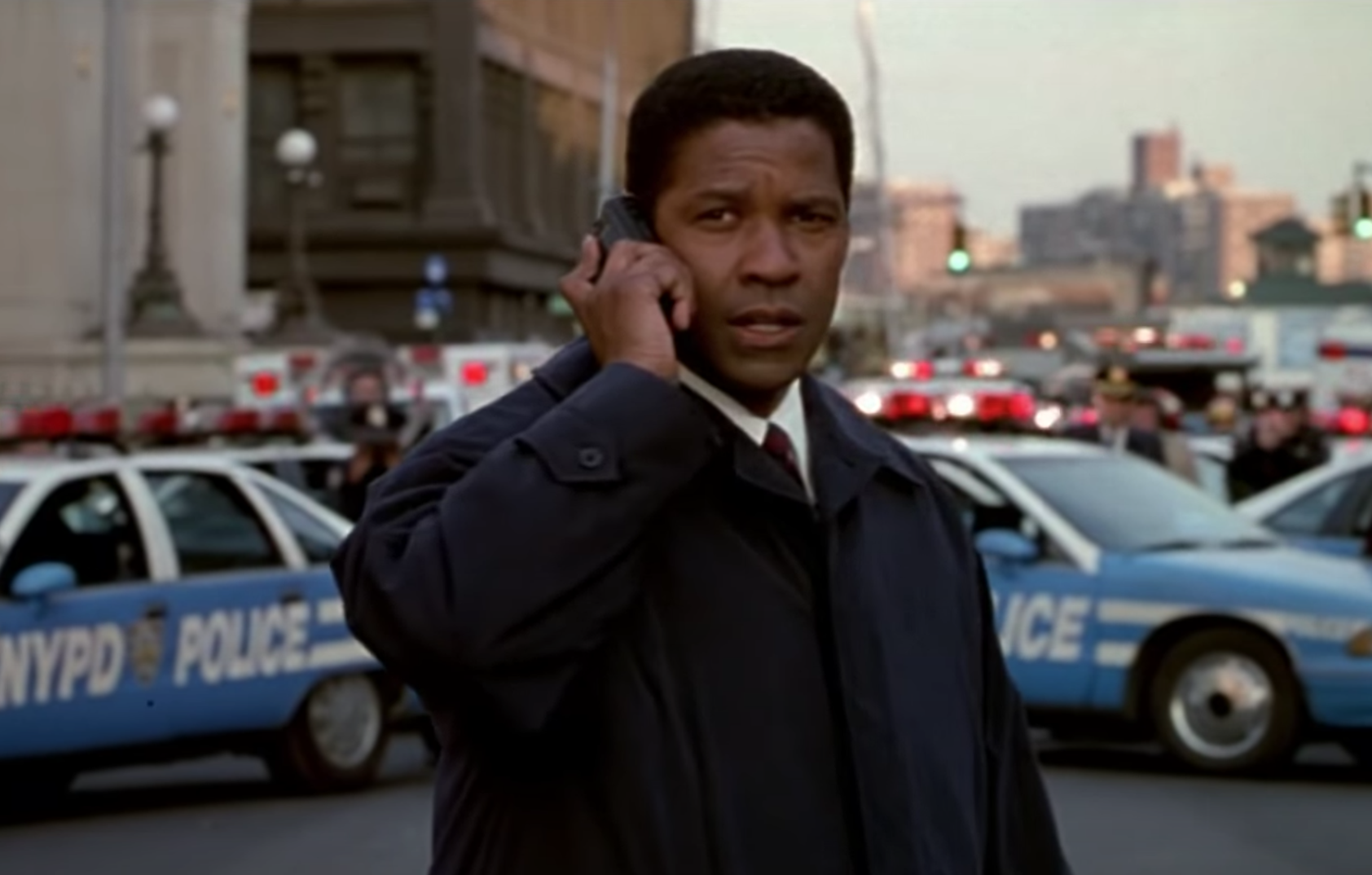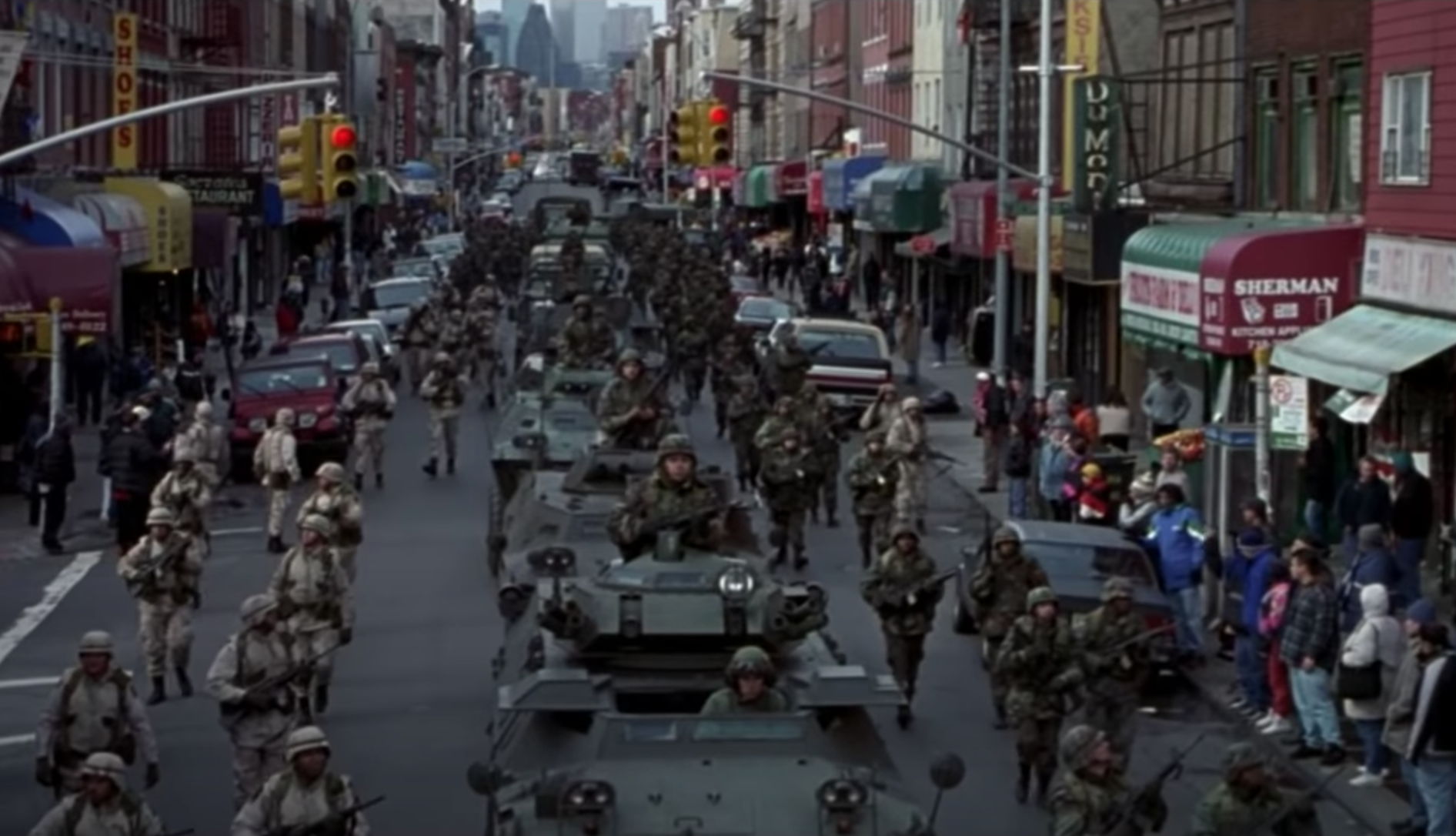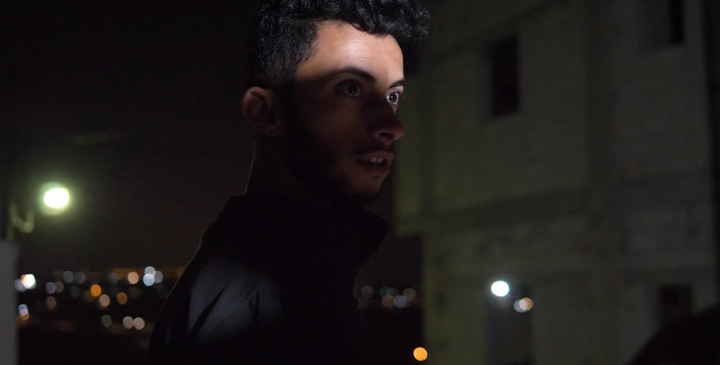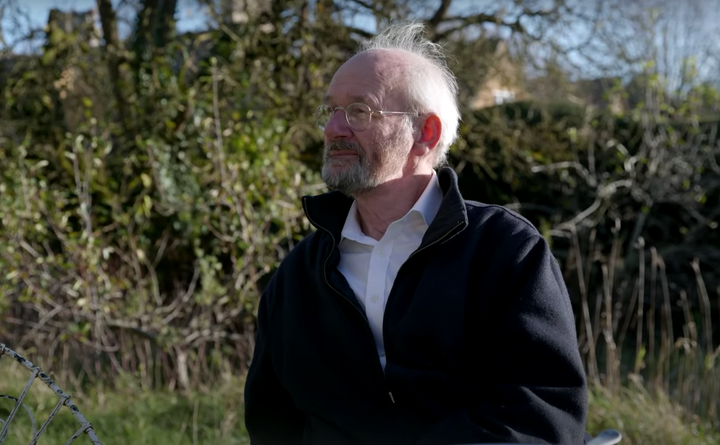9/11 Cinema: 'The Siege' Foreshadowed America's Dark Transformation
With each attack, the message of the movie is that traditional law enforcement will not stop the violence coming from within Arab and Muslim communities.

[Editor's Note: This is the first in The Dissenter's weekly series on 9/11 and its impact on cinema, which will be published as a companion to our series, "Twenty Years In A Security State."]
Yunis Shokuri, who was a Guantanamo Bay prisoner for over 13 years, once recalled the plot of “The Siege” when he appeared before a military tribunal. “The movie was about terrorists carrying out terrorist attacks in the United States.”
“The CIA and FBI were not successful in finding that terrorist group, and the United States Army interfered and gathered all the people of Arabic descent and put them in a land cage or camp just like it happened in Kandahar.”
Shokuri wondered, “Am I in that movie or on a stage in Hollywood?” and, “When does that movie end?”
Civil society organizations representing Arab and Muslim Americans protested how “The Siege” portrayed their communities as places uniquely prone to engage in terrorism.
Prior to completion, the movie’s producers met with representatives from the Council on American Islamic Relations (CAIR), along with writer Jack Shaheen, who later authored Reel Bad Arabs: How Hollywood Vilifies A People. But the filmmakers resisted changes that would have helped the production avoid crude stereotypes.
Director Edward Zwick’s insensitivity resulted in a movie that plays like post-9/11 liberal propaganda for a strong response to the threat of terrorism so long as the military and government does not cross certain boundaries. It condones abuses of power by the FBI and police as necessary to prevent violence while presenting the CIA and a bad apple military general as devious and untrustworthy.
The movie was released in 1998 and based on a story by New Yorker magazine writer Lawrence Wright. It starred Denzel Washington, as FBI Special Agent Anthony Hubbard in New York, Annette Bening, as CIA agent Elise Kraft, and Bruce Willis, the conniving Major General Bill Devereaux, who commands the U.S. Army’s 101st Airborne Division as it deploys to New York to enforce martial law.
A nightmare chain of events unfolds that in many ways foreshadow America’s response to the September 11th attacks. The CIA kidnaps Sheikh Ahmed bin Talal, a terrorism suspect, and holds him incommunicado refusing to inform the White House that they have him in custody. Islamic centers of worship are viewed as likely havens for sleeper cells.
Though the CIA is not allowed to conduct operations on U.S. soil, Kraft does not trust the FBI. She has a team pursuing their own mission in response to the terrorism threat in New York, which is blowback for the CIA’s rendition against Talal.
Kraft has a sexual relationship with her source Samir Nazhde, who was part of a group of militants that received funding to oppose Saddam Hussein’s regime in Iraq. He is tied to the very people plotting attacks in New York, which reflects the CIA tactic of arming “rebels” to force regime change. It parallels the CIA’s own history with Osama bin Laden and the mujahideen in Afghanistan because later we learned she taught Nazhde how to make bombs. She then helped him and a few other militants flee to the United States.
After the first terrorist attack, Hubbard addresses an FBI meeting. He acknowledges the willingness of the Arab community to cooperate with law enforcement. However, he declares, “I want to rumble every trap, hole, market, community center, every student organization that has ever said a bad word about this country. I want to know about them. I want you to turn the heat up under every one of your resources, every one.”
“Every source, turn him upside down. See what falls out of his pockets. Shake the trees. Throw some money at him. Whatever it takes. I want results. Call your families, find a sleeping bag because nobody is going until we find a strand to pull on,” Hubbard further states.
Racial profiling and the swarming of an entire community in New York is treated as appropriate. Not long after, Hubbard is on the phone asking a judge for a warrant for surveillance against a suspect (Aasif Mandvi) that he is already staking out from his car. (Remarkably, in a later scene, Hubbard warns against shredding the Constitution to fight terrorism.)
It is the FBI special agent who viewers are supposed to see as incorruptible. Hubbard objects when he learns the CIA is in the kidnapping business. Kraft replies, “In this game, the most committed wins.” She later says, “Your quaint laws, they don’t mean shit to these people.”
This mirrors the false dichotomy between the FBI and the CIA that has existed during the “Global War on Terrorism.”
As Spencer Ackerman reported in 2011, FBI training materials taught agents that “mainstream” American Muslims are “likely to be terrorist sympathizers, that the Prophet Mohammed was a ‘cult leader’; and that the Islamic practice of giving charity is no more than a “funding mechanism for combat.”
Agents at the FBI’s training facility in Quantico were shown a chart that suggested “the more ‘devout’ a Muslim, the more likely he is to be ‘violent,’” according to Ackerman. “The same presentation said, ‘Any war against non-believers is justified’ under Muslim law; a ‘moderating process cannot happen if the Koran continues to be regarded as the unalterable word of Allah.’”
‘A State Of Martial Law’
With each attack, the message is that traditional law enforcement will not stop the violence. Members of a war council advocate for the military to deploy to New York City. A news clip shows a pundit played by Arianna Huffington advocating for martial law. “How many people have to die before we do bring the Army?”
Much of this part of the movie presages the passage of legislation one week after 9/11 that authorized the use of military force, which President George W. Bush’s administration used as a blank check to wage war anywhere they could claim a terrorist group operated.

The 101st Airborne is deployed to New York, and Devereaux gives a speech outlining what we today would recognize as a counterinsurgency strategy:
Today, with the invocation of the War Powers Act by the president, I am declaring a state of martial law in this city. To the best of our knowledge we are opposed by no more than twenty of the enemy. He is hiding among a population of roughly two million. Intelligence tells us that he is most likely Arab-speaking, between the ages of 14 and 30, narrowing the target to 15,000 suspects. We can further reduce that number to those that have been in this country for less than six months. Now you have 20 hiding among 2,000.
If you are one of these 20 young men, you can hide among a population of similar ethnic background. Unfortunately, for you, you can only hide there, and that population in a classic immigration pattern is concentrated, right here, in Brooklyn. We intend to seal off this borough, and we intend to squeeze it.
While viewers hear the speech, a montage shows the military rolling through Brooklyn in tanks. They conduct stop-and-frisks. Dogs sniff cars for explosives. Soldiers load hand-cuffed Arab men into trucks to be transported to a detention camp. They set up a military checkpoint on the Brooklyn Bridge. More soldiers chase youth down the street with their rifles in the air. Finally, a line of Arab men in zip ties appear on screen.
“This is the land of opportunity, gentlemen, the opportunity to turn yourselves in. After sundown tonight, any young man fitting the profile I’ve described who has not cooperated will be arrested and detained,” Devereaux declares. “There is historically nothing more corrosive to the morale of a population than policing its own citizens, but the enemy would be sadly mistaken if they were to doubt our resolve. They are now face to face with the most fearsome military machine known to man, and I intend to use it and be back on base in time for the playoffs.”
Devereaux’s speech may have sounded hammy in 1998, but after 9/11, it is not so over the top.
A memo dated October 23, 2001, from Deputy Assistant Attorney General John Yoo and Special Counsel Robert Delahunt explicitly stated, “We conclude that the president has both constitutional and statutory authority to use the armed forces in military operations against terrorists within the United States.”
“We believe that these operations generally would not be subject to the constraints of the Fourth Amendment so long as the armed forces are undertaking a military function. Even if the Fourth Amendment were to apply, however, we believe that most military operations would satisfy the Constitution’s reasonableness requirement and continue to be lawful.”
Their rationale is identical to the justification for martial law in “The Siege.”
[This] is armed conflict between a nation-state and an elusive clandestine group or network of groups striking unpredictably at civilian and military targets both inside and outside the United States. Because the scale of the violence involved in this conflict removes it from the sphere of operations designed to enforce the criminal laws, legal and constitutional rules regulating law enforcement activity are not applicable, or at least not mechanically so.
As a result, the uses of force contemplated in this conflict are unlike those that have occurred in America’s other recent wars. Such uses might include, for example, targeting and destroying a hijacked civil aircraft in circumstances indicating that hijackers intended to crash the aircraft into a populated area; deploying troops and military equipment to monitor and control the flow of traffic into a city; attacking civilian targets, such as apartment buildings, offices, or ships where suspected terrorists were thought to be; and employing electronic surveillance methods more powerful and sophisticated than those available to law enforcement agencies.
Although it does not say anything about establishing an internment camp, all of the above uses of force are approved in the final portion of the movie. Devereaux even flies a helicopter and launches missiles into an auto shop, where there is a suspected terrorist.
Only Arabs Come From Nations That The US Is At War With Indefinitely
The audience is not supposed to leave the movie thinking entire institutions could be corrupted by the thirst for revenge against terrorists. Denzel Washington’s character puts a stop to the evil military general, who single-handedly orchestrated the military occupation of New York, and Devereaux is marched away in handcuffs.
A “making of” special on the movie from HBO featured Zwick insisting the story was “based on truth, rather than a [fiction] thriller.” Washington told Matt Lauer, host of NBC’s “Today,” “We’re imitating life. [The film] does not paint all Arabs as suicide bombers.”
“You’re getting some heat from Arab groups,” Lauer said. “In certain countries, they wouldn’t even be allowed to do that,” Washington replied.
Shaheen noted in Reel Arabs that the U.S. military conducted “Urban Warrior” exercises in March 1999, in Monterey and Oakland, California. Actors were asked to portray “disloyal Arab Americans.” They were instructed to “appear in crowded urban areas, harass the Marines, and then stop them from tracking ‘terrorists.’”
“Of all our ethnic groups, only Arabs come from nations that are currently in a state of indefinitely suspended war with the United States,” film critic Roger Ebert wrote. “The vast majority of Arab Americans are patriotic citizens who are happy to plunge into the melting pot with the rest of us (a point the movie does make), but a minority have been much in the news, especially after the World Trade Center bombing in New York City.”
“Many Americans do not draw those distinctions and could not check off on a list those Arab countries we consider hostile, neutral or friendly. There is a tendency to lump together “towelheads” (a term used in the movie). Arab-Americans feel vulnerable right now to the kinds of things that happen in this movie, and that’s why it’s not the same thing as targeting other ethnic groups.”
“The prejudicial attitudes embodied in the film are insidious, like the anti-Semitism that infected fiction and journalism in the 1930s—not just in Germany, but in Britain and America,” Ebert added.
It was 1998. Movies like “The Siege” raise the question, how much did 9/11 really change the United States? Perhaps, the so-called 9/11 ideology was already embedded. Political and military elites just needed a catalyst to seize upon that ideology and manufacture the security state of their imaginations.




Comments ()